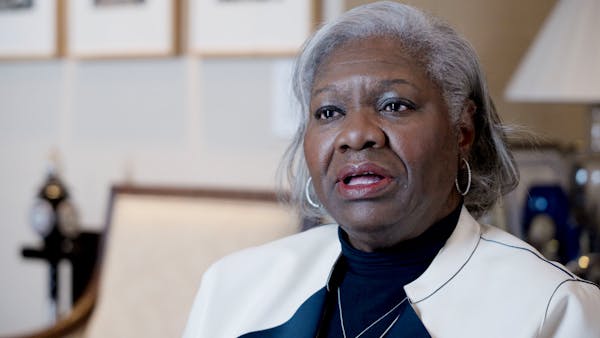Hamline University President Fayneese Miller on Monday announced plans to retire, months after a controversy over Islamic artwork drew attention to the St. Paul school and her leadership of it.
At a news conference, Miller said she will retire in the summer of 2024, primarily for personal reasons. She said she hoped to spend more time with her husband who lives in Vermont and her son who lives in Los Angeles. During the pandemic, she said she opted to remain in St. Paul.
"I was here doing the business of Hamline University. It is time for my family to be together," she said.
Miller drew a mixture of fierce supporters and staunch critics in months after the university decided not to renew the contract for an art history instructor who showed images of the Prophet Muhammad in class. She pushed back at Monday's news conference against what she described as a "false narrative" that the university had trampled on the instructor's academic freedom.
"No one was let go for sharing an image," she said.
An attorney for the instructor declined to comment.
In a retirement announcement, the university highlighted Miller's efforts to balance budgets, promote inclusion and create opportunities for students who could use financial assistance.
Miller became Hamline's second female president in 2015. In multiple years before she arrived, the university had been operating in the red, according to public tax filings.
More recent filings from 2016 through 2020 showed that each year the university brought in more in more money than it spent — though the amount ranged from about $740,000 to nearly $11 million. During that time, the number of students dropped from about 4,500 to 3,400, and the number of employees dropped from 2,324 to 1,503. Filings for 2021 haven't been released.
Debate over Islamic art
Miller's leadership of the private school had been the subject of intense debate following an episode that raised concerns about academic freedom, religious tolerance and Islamophobia. The university is facing a lawsuit from the former art history instructor, whose contract was not renewed after she showed centuries-old artworks depicting the Prophet Muhammad in class. Throughout history, scholars and religious leaders have sometimes disagreed over whether Islam permits images of the prophet.
The instructor's supporters argued that she had done more than most to prepare students for the images and gave them an opportunity to opt out of seeing them. Others argued that her "trigger warnings" were a sign she shouldn't have shown the images in the first place.
As the incident — and the university's handling of it — drew international attention in academic circles, faculty called on Miller to resign immediately, saying they "no longer have faith" in her ability to lead. Supporters suggested that Miller, the university's first Black president, was being unfairly targeted for her race and for changes she made to help the campus survive financial challenges and enrollment declines.
Jim Scheibel, president of the university's Faculty Council, said Monday: "There is a lot of work that needs to be done. There has been some damage that has been done that has to be repaired and then, most importantly, we need to look at Hamline in 2024 and beyond."
Scheibel said he is committed to working with Miller while she remains at the university, crediting her for supporting students and bringing a civil rights background to the university. But, he also said he's going to be focused on what's coming next, saying he is encouraged that trustees have indicated faculty will help select the interim president and work to develop a strategic plan.
"We have concerns about how it's going to impact enrollment and the impact it might have on faculty," he said, adding that some had discussed the possibility of leaving before news broke of Miller's retirement announcement.
After the news of Miller's departure became public, Jaylani Hussein, executive director of the Minnesota chapter of the Council on American-Islamic Relations, said he was disappointed and concerned for students and faculty of color. During the debate over the artwork, Hussein had advocated for the student who was offended, arguing the image of the prophet should not have been shown.
He called Miller "an incredible university leader of color" who worked to increase enrollment and create a welcoming campus for minority students.
"It's not a good day for the state of Minnesota and for the incredible progress she spent years building," Hussein said.
Long career in academia
Miller had decades of experience in academia before coming to Hamline. She has a background in social psychology and spent about 20 years at Brown University, where she helped found an ethnic studies program and served as director for the Center for the Study of Race and Ethnicity in America. Miller was working at the University of Vermont as dean of the college of education and social services when Hamline tapped her to serve as its president.
Reflecting on her tenure at Hamline during Monday's news conference, Miller said she was particularly proud of the university's COVID-19 response and how the school never shut the dorms because "we didn't make the assumption that our students had a safe place to go."
And she urged higher education institutions to evolve to meet students' needs, saying, "It's not students who need to change to meet us. It's us who need to change to meet them."
It was not immediately clear when the university will begin searching for a new president. Miller said she can "count on one hand" the number of vacation days she's taken since her hiring at Hamline.
"I need a break for a while," Miller said.

Want to share info with the Star Tribune? How to do it securely

'Safe recovery sites' would offer syringes, naloxone and more to people using drugs. The plan could be in peril.
New Minnesota GOP leaders seek peace with party's anti-establishment wing

Who is Republican Lisa Demuth, Minnesota's first House speaker of color?

